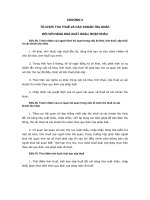chương 2 tổ chức chiến lược và lựa chọn dự án
Bạn đang xem bản rút gọn của tài liệu. Xem và tải ngay bản đầy đủ của tài liệu tại đây (655.85 KB, 27 trang )
McGraw-Hill/Irwin © 2008 The McGraw-Hill Companies, All Rights Reserved
Organization
Strategy and
Project
Selection
Chapter 2
2-2
2-3
Why Project Managers Need to Understand
the Strategic Management Process
Changes in the Organization’s Mission
and Strategy
Project managers must respond to changes
with appropriate decisions about future
projects and adjustments to current projects.
Project managers who understand their
organization’s strategy can become effective
advocates of projects aligned with the firm’s
mission.
2-4
The Strategic Management Process:
An Overview
Strategic Management
Provides the theme and focus of the future
direction for the firm.
o
Responding to changes in the external
environment—environmental scanning
o
Allocating scarce resources of the firm to
improve its competitive position—internal
responses to new action programs
Requires strong links among mission, goals,
objectives, strategy, and implementation.
2-5
Strategic Management Process (cont’d)
Four of Activities of the Strategic
Management Process
1. Review and define the organizational
mission.
2. Set long-range goals and objectives.
3. Analyze and formulate strategies to reach
objectives.
4. Implement strategies through projects.
2-6
Strategic
Management
Process
FIGURE 2.1
2-7
Characteristics of Objectives
EXHIBIT 2.1
S Specific Be specific in targeting an objective
M Measurable Establish a measurable indicator(s) of progress
A Assignable Make the objective assignable to one person for
completion
R Realistic State what can realistically be done with available
resources
T Time related
2-8
Project Portfolio Management Problems
The Implementation Gap
The lack of understanding and consensus on strategy
among top management and middle-level (functional)
managers who independently implement the strategy.
Organization Politics
Project selection is based on the persuasiveness and
power of people advocating the projects.
Resource Conflicts and Multitasking
The multiproject environment creates
interdependency relationships of shared resources
which results in the starting, stopping, and restarting
projects.
2-9
Benefits of Project Portfolio Management
Builds discipline into project selection process.
Links project selection to strategic metrics.
Prioritizes project proposals across a common set of
criteria, rather than on politics or emotion.
Allocates resources to projects that align with
strategic direction.
Balances risk across all projects.
Justifies killing projects that do not support
organization strategy.
Improves communication and supports agreement
on project goals.
EXHIBIT 2.2
2-10
Portfolio of Projects by Type
FIGURE 2.2
2-11
A Portfolio Management System
Selection Criteria
Financial: payback, net present value (NPV),
internal rate of return (IRR)
Non-financial: projects of strategic
importance to the firm.
Multi-Weighted Scoring Models
Use several weighted selection criteria to
evaluate project proposals.
2-12
Financial Models
The Payback Model
Measures the time it will take to recover the
project investment.
Shorter paybacks are more desirable.
Emphasizes cash flows, a key factor in business.
Limitations of payback:
o
Ignores the time value of money.
o
Assumes cash inflows for the investment period
(and not beyond).
o
Does not consider profitability.
2-13
Financial Models (cont’d)
The Net Present Value (NPV) Model
Uses management’s minimum desired rate-of-
return (discount rate) to compute the present
value of all net cash inflows.
o
Positive NPV: the project meets the minimum
desired rate of return and is eligible for further
consideration.
o
Negative NPV: project is rejected.
2-14
Net Present Value (NPV) and Internal Rate of Return
(IRR):
Example Comparing Two Projects
EXHIBIT 2.3
2-15
Nonfinancial Criteria
To capture larger market share
To make it difficult for competitors to enter
the market
To develop an enabler product
To develop core technology that will be used
in next-generation products
To reduce dependency on unreliable
suppliers
To prevent government intervention and
regulation
2-16
Checklist Selection Model
Strategy alignment: What specific organization does this
project align with?
Driver: What business problem does the project solve?
Success metrics: How will we measure success?
Sponsorship: Who is the project sponsor?
Risk: What is the impact of not doing this project?
Risk: What is the project risk to our organization?
Benefits: What is the value of the project to this
organization?
Organization culture: Is our organization culture right for this
type of project?
Approach: Will we build or buy?
Training/resources: Will staff training be required?
Finance: What is estimated cost of the project?
Portfolio: How does the project interact with current projects?
2-17
Project Screening Matrix
FIGURE 2.3
2-18
Applying a Selection Model
Project Classification
Deciding how well a strategic or operations project fits
the organization’s strategy.
Selecting a Model
Applying a weighted scoring model to bring projects to
closer with the organization’s strategic goals.
o
Reduces the number of wasteful projects
o
Helps identify proper goals for projects
o
Helps everyone involved understand how and why
a project is selected
2-19
Project Proposals
Sources and Solicitation of Project Proposals
Within the organization
Request for proposal (RFP) from external sources
(contractors and vendors)
Ranking Proposals and Selection of Projects
Prioritizing requires discipline, accountability,
responsibility, constraints, reduced flexibility, and loss
of power
Managing the Portfolio
Senior management input
The priority team (project office) responsibilities
2-20
Major
Project
Proposal
FIGURE 2.4A
2-21
Risk
Analysis
FIGURE 2.4B
2-22
Managing the Portfolio
Senior Management Input
Provide guidance in selecting criteria that are aligned
with the organization’s goals
Decide how to balance available resources among
current projects
The Priority Team Responsibilities
Publish the priority of every project
Ensure that the project selection process is open and
free of power politics
Reassess the organization’s goals and priorities
Evaluate the progress of current projects
2-23
Project
Screening
Process
FIGURE 2.5
2-24
Priority
Analysis
FIGURE 2.6
2-25
Project Portfolio Matrix
FIGURE 2.7









